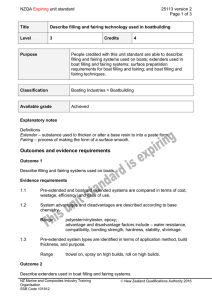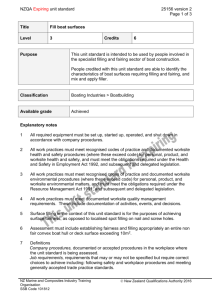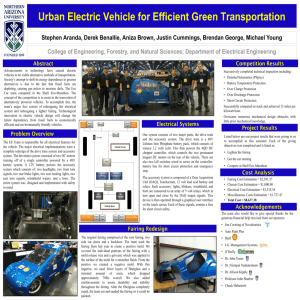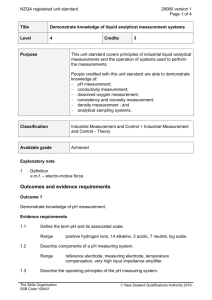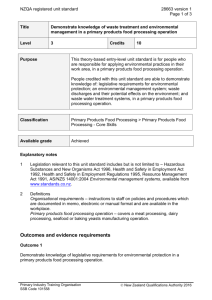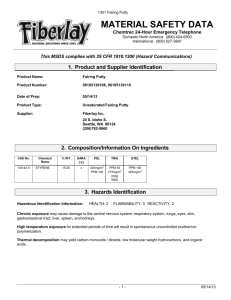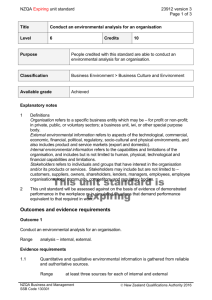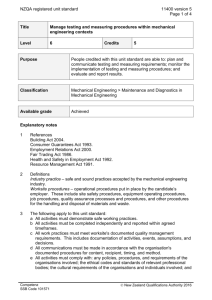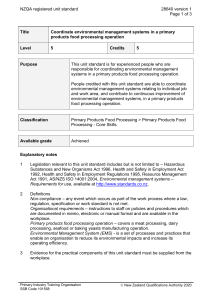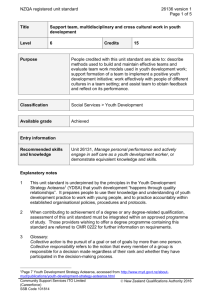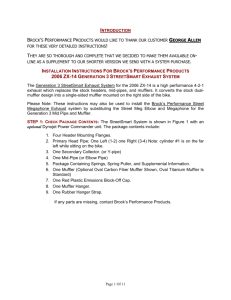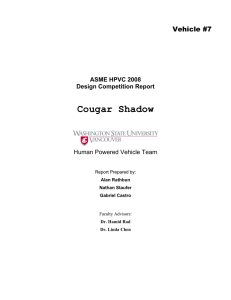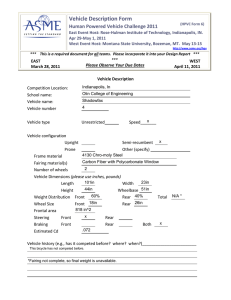NZQA registered unit standard 29235 version 1 Page 1 of 4 Title
advertisement
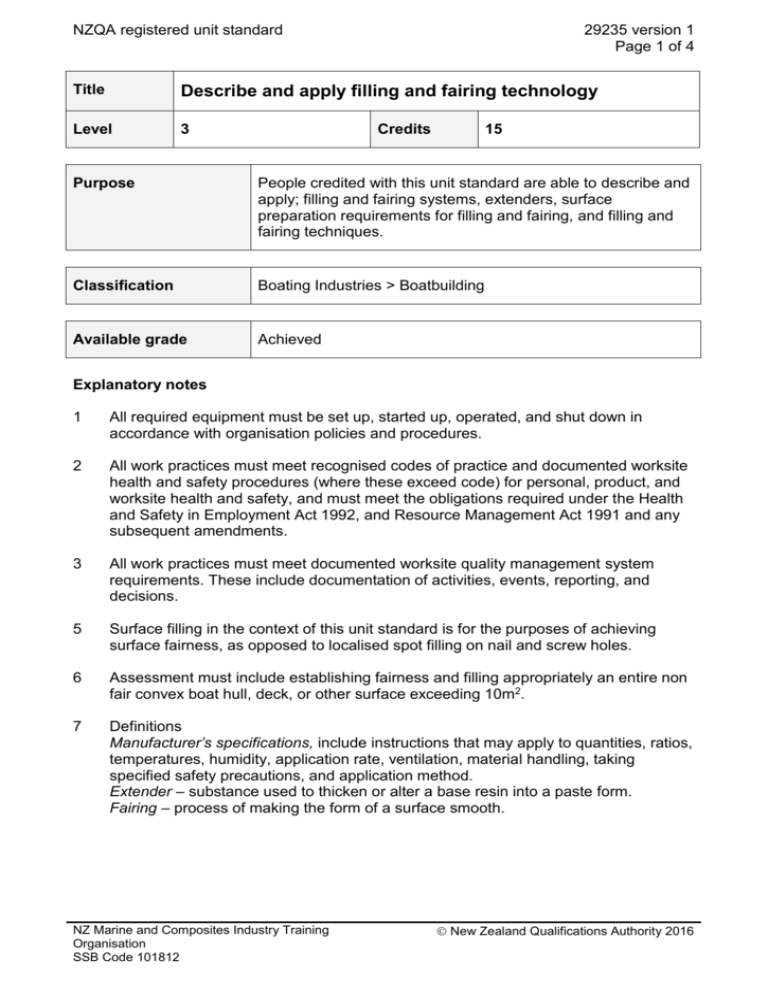
NZQA registered unit standard 29235 version 1 Page 1 of 4 Title Describe and apply filling and fairing technology Level 3 Credits 15 Purpose People credited with this unit standard are able to describe and apply; filling and fairing systems, extenders, surface preparation requirements for filling and fairing, and filling and fairing techniques. Classification Boating Industries > Boatbuilding Available grade Achieved Explanatory notes 1 All required equipment must be set up, started up, operated, and shut down in accordance with organisation policies and procedures. 2 All work practices must meet recognised codes of practice and documented worksite health and safety procedures (where these exceed code) for personal, product, and worksite health and safety, and must meet the obligations required under the Health and Safety in Employment Act 1992, and Resource Management Act 1991 and any subsequent amendments. 3 All work practices must meet documented worksite quality management system requirements. These include documentation of activities, events, reporting, and decisions. 5 Surface filling in the context of this unit standard is for the purposes of achieving surface fairness, as opposed to localised spot filling on nail and screw holes. 6 Assessment must include establishing fairness and filling appropriately an entire non fair convex boat hull, deck, or other surface exceeding 10m2. 7 Definitions Manufacturer’s specifications, include instructions that may apply to quantities, ratios, temperatures, humidity, application rate, ventilation, material handling, taking specified safety precautions, and application method. Extender – substance used to thicken or alter a base resin into a paste form. Fairing – process of making the form of a surface smooth. NZ Marine and Composites Industry Training Organisation SSB Code 101812 New Zealand Qualifications Authority 2016 NZQA registered unit standard 29235 version 1 Page 2 of 4 Outcomes and evidence requirements Outcome 1 Describe filling and fairing systems. Evidence requirements 1.1 Pre-extended and extended systems are compared in terms of cost, wastage, efficiency, and ease of use. 1.2 Resin system advantages and disadvantages are described with reference to their properties. Range 1.3 may include - polyester/vinylester, epoxy; properties may include – water resistance, compatibility, bonding strength, hardness, stability, shrinkage. evidence of at least two resin systems. Pre-extended system types are described in terms of the application method, build thickness, and purpose. Range evidence of three application methods is required. Outcome 2 Describe and apply extenders used in filling and fairing systems. Evidence requirements 2.1 Extenders advantages and disadvantages are described, with reference to their properties, when mixed into a filling or fairing compound. Range extenders may include – talc, silica, micro-balloons; properties may include – shaping, sanding, hardness, stability, mixing, cost, application. Evidence of two extenders is required. Outcome 3 Describe and apply surface preparation requirements for filling and fairing. Evidence requirements 3.1 Surface preparation and cleaning requirements prior to application of filling or fairing compound are described according to medium. Range preparation includes cleaning, identification and marking of highs and lows surfaces may include - steel, aluminium, composite, timber. evidence of two surfaces is required. NZ Marine and Composites Industry Training Organisation SSB Code 101812 New Zealand Qualifications Authority 2016 NZQA registered unit standard 3.2 29235 version 1 Page 3 of 4 Surface preparation is verified in accordance with job requirements and manufacturer’s specifications. Outcome 4 Describe and apply filling and fairing techniques. Evidence requirements 4.1 Filler is progressively checked during shaping using battens, and highs and lows are identified in accordance with task requirements. 4.2 The stages of filler application are described and applied in terms of the progression of the fairing process. Range initial fairing application, localised application. 4.3 Surface is filled so that fair lines are achieved across the entire surface in accordance with task requirements. 4.4 Cured filler is checked for hardness in accordance with task requirements and manufacturer’s specifications. 4.5 Use of battens is described and applied in terms of establishing fair surfaces. Range 4.6 batten length and rigidity, batten selection according to surface curvature, localised fairness, overall fairness, marking out. Use of shaping and smoothing tools is described and applied in terms of establishing fair and smooth surfaces. Range includes planes, sanding boards, sanding machines. Replacement information This unit standard replaced unit standard 25113, 25155, and 25156. Planned review date 31 December 2020 NZ Marine and Composites Industry Training Organisation SSB Code 101812 New Zealand Qualifications Authority 2016 NZQA registered unit standard 29235 version 1 Page 4 of 4 Status information and last date for assessment for superseded versions Process Version Date Last Date for Assessment Registration 1 15 October 2015 N/A Consent and Moderation Requirements (CMR) reference 0136 This CMR can be accessed at http://www.nzqa.govt.nz/framework/search/index.do. Please note Providers must be granted consent to assess against standards (accredited) by NZQA, before they can report credits from assessment against unit standards or deliver courses of study leading to that assessment. Industry Training Organisations must be granted consent to assess against standards by NZQA before they can register credits from assessment against unit standards. Providers and Industry Training Organisations, which have been granted consent and which are assessing against unit standards must engage with the moderation system that applies to those standards. Requirements for consent to assess and an outline of the moderation system that applies to this standard are outlined in the CMRs. The CMR also includes useful information about special requirements for organisations wishing to develop education and training programmes, such as minimum qualifications for tutors and assessors, and special resource requirements. Comments on this unit standard Please contact the New Zealand Marine and Composite Industry Training Organisation training@bia.org.nz if you wish to suggest changes to the content of this unit standard. NZ Marine and Composites Industry Training Organisation SSB Code 101812 New Zealand Qualifications Authority 2016
